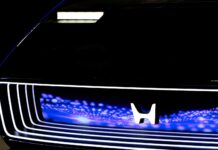Mazda faces a critical crossroads. The company, already deep into developing its own bespoke electric vehicle (EV) architecture, finds its ambitions for the highly anticipated Iconic SP sports car concept increasingly constrained by financial realities.
🚗 The Iconic SP’s Promise
Unveiled at the 2023 Tokyo Motor Show, the Iconic SP is a captivating concept. Presented as a two-seat coupé roughly the size of Mazda’s popular MX-5, it represents a fascinating blend of old and new. Designed with a potential production future in mind, this concept car features a unique drivetrain: a 360bhp range-extender electric powertrain coupled with a small-displacement rotary engine. This engine isn’t meant for primary propulsion but serves as a generator to extend the car’s electric range during driving.
Mazda’s design chief, Masahi Nakayama, previously fueled optimism, stating the Iconic SP was far more than a typical concept car. He emphasized it was “designed with real intent to turn it into a production model in the not so distant future” and noted it was engineered with homologation (the process of bringing a concept to market) from the start.
Chief Technology Officer Ryuichi Umeshita also expressed personal passion for the project, calling it “my dream car” and believing the technology to bring it to life is feasible. His main hurdle, he acknowledged, is purely financial.
💰 The Price of EV Dreams
However, two years after the Iconic SP’s debut, the landscape has shifted dramatically. Mazda is heavily invested in a costly, custom-built EV architecture. This bespoke system is designed to be the foundation for its first dedicated EV, planned for introduction around 2027. This major undertaking requires significant investment.
The company has recently announced a drastic reduction in its planned spending on future electrification. Looking ahead to 2030, Mazda intends to slash its investment in this area by approximately £2.5 billion – roughly a third of its original projected budget. This sharp cutback inevitably impacts all EV development programs, including those stemming from concepts like the Iconic SP.
📌 A Shift in Priorities
While executives like Nakayama and Umeshita maintain hope for the Iconic SP, the company’s strategic direction points towards other priorities. The substantial financial commitment required to adapt the Iconic SP concept to Mazda’s existing (or soon-to-be-developed) EV architecture appears to have become a significant obstacle. Building a bespoke architecture and simultaneously launching a new sports car model on that architecture would require immense resources.
The Iconic SP concept, with its unique rotary-electric hybrid powertrain, represents a specific engineering challenge within the broader EV framework. Given the budget constraints, this particular path might be deemed less feasible than other EV projects aligned more closely with the core architecture being developed.
💎 Conclusion
The Iconic SP captured the imagination of car enthusiasts with its promise of blending classic Mazda sporting form with cutting-edge electric technology. While driven by passion and technical possibility, its production seems increasingly unlikely due to Mazda’s challenging financial position and strategic focus on the high-cost development of its new EV platform. The dream of a production Iconic SP may be facing the harsh realities of the EV market’s financial demands, highlighting the tough choices automakers face during the industry’s transition





































